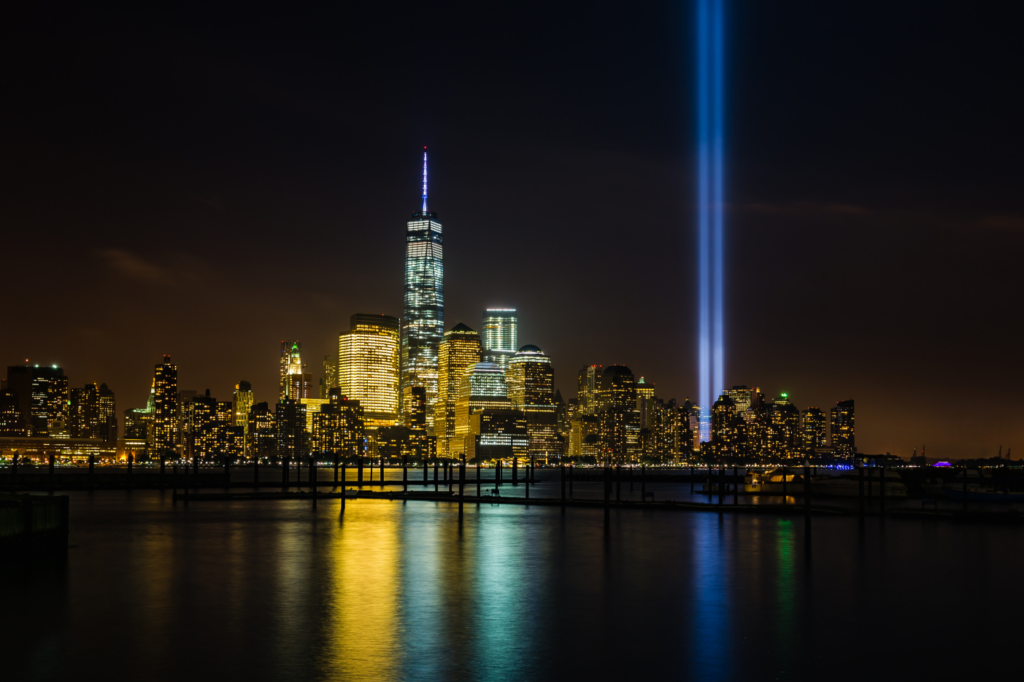How Trauma Changes Us: Life after 9/11
Marian Fontana’s husband was a firefighter who perished at the World Trade Centers. Sandro Galea is a medical epidemiologist whose research team interviewed 10,000 New Yorkers after the terrorist attacks of 2001. The two shared their perspectives on the psychological effects of mass trauma.
Published December 2, 2005
By Adrienne Burke
Academy Contributor

Author and comedienne Marian Fontana is living proof of epidemiologist Sandro Galea’s finding that “people are immensely resilient in the face of disaster.”
Fontana, like thousands of other Americans, was catapulted into a new reality on September 11, 2001. When her husband Dave, a Brooklyn firefighter, perished at the World Trade Center on the morning of their eighth wedding anniversary, Fontana found herself, suddenly at 34, a widow, a single mother, and, shortly thereafter, president of the 9/11 Widows and Victims’ Families Association.
On the fourth anniversary of the tragedy, Fontana read from her new book, A Widow’s Walk: A Memoir of 9/11 at a Readers & Writers salon hosted by Science & the City at The New York Academy of Sciences (the Academy). The event took place during a three-day symposium, Psychobiology of Post-traumatic Stress Disorder: A Decade of Progress, organized by the Bronx VA Medical Center and hosted by the Academy and Mt. Sinai School of Medicine.
Sandro Galea, who, as a medical epidemiologist at the New York Academy of Medicine, studied the psychological effects of the World Trade Centers disaster, augmented Fontana’s reading with a discussion about the data his team gathered in interviews with 10,000 New Yorkers. His research offers a perspective on the emotional consequences of mass trauma for the population at large, and insight into risk factors for post-traumatic stress disorder.
Describing Fontana’s book as “immensely funny, profoundly sad, and sometimes both simultaneously,” Galea noted that science is seldom funny or sad, but that “the scientific study of people in disaster is important just as is the literary study of disaster, and the two can feed off each other.”
Trauma and Transformation
To be sure, A Widow’s Walk has none of the characteristics of a scientific study; it reads like an overwhelmingly painful conversation with a grieving best friend, all raw emotion, honest confessions, and hard truths. At times a love story, the book resists gilding the memory of a partnership that began in college. And Fontana doesn’t shy from baring family tensions, admitting to being impatient with her son, or calling out the insensitivity and manipulations of strangers. She exposes her own bouts of self-absorption, manages to crack jokes at the heaviest moments, and easily brings her readers to tears again and again.
Certain anecdotes—of binge drinking, deferred counseling, and denials of reality—hint at how many grieving widows, families, and firemen suffered after September 11. But in her descriptions of funerals, memorial services, nights out with the “Merry Widows,” family holidays, and conversations with her husband’s colleagues are clues to how this woman not only survived, but thrived in the face of tragedy, with a sense of humor and a creative will intact.
In one excerpt from the book that Fontana read aloud at the Academy, she recalls an episode when, angry with a firefighter for getting too drunk to drive her safely home from a memorial service, Fontana throws his beeper out of a moving bus. In another chapter, Fontana’s son Aidan, who was in his second day of kindergarten the day his father died, admonishes her against sitting on the firefighter angel that he believes is keeping him company in his bedroom.
Through the lens of an epidemiologist, this bird’s eye view of a single mother surviving tragedy with the support of a wide network of family, friends, and community is, Galea said, “seeing a multivariable statistical model in a much more interesting way.”
Small Percentage, Big Numbers
Though about half of New Yorkers suffered no symptoms at all of post-traumatic stress or depression after September 11, Galea said his research has shown that disaster and mass traumas affect everybody. “People who live through disasters change and there is a new normal afterwards,” he said. “Marian’s book is an incredible testament to that. Some of the change is for the worse. Sometimes it’s for the better—there are opportunities for personal growth.”
For instance, Galea’s studies revealed that after September 11, two-thirds of New Yorkers felt less hopeful about the future. But about half were spending more time with their children. About one-fourth admitted being afraid of going into tall buildings, but more than two-thirds said they felt their life had more meaning than before September 11.
“Mass disasters are transformative for thousands, millions of people,” Galea said. “It’s hard to think of other phenomena that can affect the lives and behavior of so many people all in an instant.”
Galea also noted that, though a minority, the number of people who do suffer adverse mental health consequences after a disaster is not insubstantial. Events that affect densely populated areas like New York, where two percent of the population accounts for more than 100,000 people, can have dramatic impact just in sheer numbers, he noted.
Who’s at Risk?
Who is likely to suffer? Galea’s research offers some risk factors. “Even leaving the biology aside, we have a pretty good sense that certain people are more at risk after exposure to a disaster,” he said. Those without social support—family, friends, community—are at risk. People who lose their jobs due to a disaster are at greater risk, as are single mothers.
Though 9/11 left Fontana a single mother, A Widow’s Walk describes an enormously supportive community of friends and family that seemed never to leave her side for months while she grieved.
Asked to comment on how she came through such a tremendous trauma changed, but fine, Fontana said that support system was vital: “I had what felt like a hole in my heart. Seeing friends gave me the sense that that hole could be filled again. That gave me tremendous strength.”
Also in Fontana’s favor was the fact that, far from losing her job, she was able to find a sense of purpose after the tragedy as an activist and organizer protesting against the city’s treatment of firefighters and organizing for the rights of families of the 9/11 victims.
Fontana said, “I had the unfortunate experience of seeing a lot of people grieve at the same time and I can’t say that any of us did it the same. In fact, I was quite struck by how different we all felt at different times.”
Preventing PTSD
Asked what preventive steps could be taken to prevent symptoms of post-traumatic stress or depression after such a disaster, Galea said, “There’s no question there are treatments that are effective for mitigating specific psychopathologies. There are cognitive behavioral treatments, there are pharmacological treatments, that make things like post-traumatic stress symptoms get better.”
Anecdotally, Fontana said she observed that those who sought out therapy thrived better than those who didn’t. “There were guys who had been sober for 25 years and fell off the wagon. There were guys who started smoking, doing drugs. The fire department by nature doesn’t seek out mental health services. Everyone in the city was offering free mental health services. They were visiting firehouses and the firemen are very suspect…There are now firefighters seeking counseling, but it took a lot and I don’t think enough of them received the services they should and could have.”
Asked how her husband’s former colleagues seem to be faring four years on, Fontana, who had seen many firefighters at the previous day’s memorial services, replied, “not well,” citing bad dreams, unhappiness, and being haunted by memories of those their firehouses lost. “I think they’re all traumatized,” Fontana said. “I can see it in their faces. They look unhealthy, they’re gray, they’re still drinking. It’s hard to see.”
Population-Wide Solutions
As an epidemiologist, Galea is interested in population-wide solutions. The harder question, he said, is, “What treatments if any are effective at the population level soon after a disaster to reduce the prevalence of these conditions in the general population? We don’t know. The data on the extent to which people actually sought new counseling relationships at the population level after 9/11 were conflicting. They show absolutely the opposite results.”
Galea said he agrees with others who have said that, because so little is known about effective interventions, there’s an imperative to test them. “The problem is that after a disaster we tend to be very uneasy about saying we should test something,” he said.
“We have the sense that everything is so bad. How could you evil scientists talk about testing something?” Galea said. “The simple response is: that’s what drives scientific inquiry.”
And until then, books such as Fontana’s A Widow’s Walk serve as important anecdotal records of human suffering and survival.
About the Speakers
Marian Fontana, an accomplished comedienne, actress, and writer, is the president of the 9/11 Widows and Victims’ Families Association. She lives with her son, Aidan, in Staten Island, New York.
Sandro Galea, MD, DrPH, is a research affiliate in the Population Studies Center and associate professor in the epidemiology department at the University of Michigan School of Public Health. His research focuses on the effects of urban social determinants on the health of marginalized populations, including morbidity, mortality, and risk behaviors, and on the effects of trauma on mental health.
Galea is board certified in family medicine and emergency medicine and has worked as a clinician in remote rural communities in Northern Canada and in the Mudug Region, Somalia. He completed his DrPH in the Columbia University School of Public Health, an MD at the University of Toronto Medical School, and an MPH at the Harvard School of Public Health.
Also read: “Did you feel it?” How understanding small earthquakes readies us for big ones
